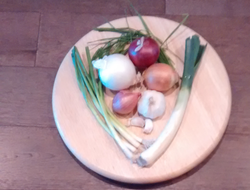Onions, other Allium and your health
Published: February 02, 2018
Onions, leeks, garlic, scallions (also known as spring onions and green onions), shallots, and chives are a few cultivated species identified as Allium: a flowering monocotyledon.
Most Alllium species are found in temperate Northern Hemisphere climates, growing to a variety of heights, with varying bulb sizes, and differing leaf base formation.
Another characteristic of these plants is the distinctive taste and odour (pungency) that they impart to varying degrees of flavour mostly provided by their cysteine sulfoxides content.
This content depends, in part, on the sulfate content of the soil they are grown in.
Pungency
The pungency of onions and garlic is measured by the "pyruvate scale" named for pyruvic acid which is metabolite produced along with syn-Propanethial-S-oxide when these Alliums are cut.
Pungency is measured in micromol/g between 1 and 10. Sweeter onions have lower scores, brown/red onions rate approximately 6-7, and white onions about 8. Factors which influence pungency include soil type, rain, and sunlight.
A variety of growing conditions suit Allium growth which range from dry to swamp/water conditions. However, only a few Allium species are economically important as commercial crops and garden vegetables.
A few species are poisonous, but these lack the typical odour associated with onions or garlic. However, certain species such as onions are highly toxic to cats and dogs. Link to the full article to learn more about Allium species and their health benefits.

